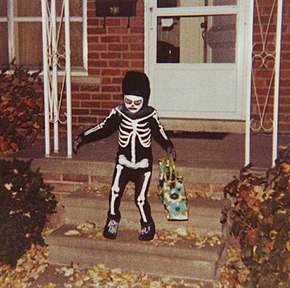TRICK-OR-TREAT
Recipe located here from a few years ago
https://recipemarketing.blogspot.com/2015/10/halloween-cupcakes-with-candy-icing.html
 |
| Halloween Cupcakes With Candy Icing |
 |
| Halloween Cupcakes With Candy Icing |
Trick-or-treating
Trick-or-treating is a Halloween ritual custom for children and adults in many countries. Children in costumes travel from house-to-house, asking for treats with the phrase "Trick or treat". The "treat" is usually some form of candy, although in some cultures money is used instead. The "trick" refers to a threat, usually idle, to perform mischief on the homeowners or their property if no treat is given. Trick-or-treating usually occurs on the evening of October 31. Some homeowners signal that they are willing to hand out treats by putting up Halloween decorations outside their doors; others simply leave treats available on their porches for the children to take freely.
In North America, trick-or-treating has been a Halloween tradition since the late 1920s. In Britain and Ireland the tradition of going house-to-house collecting food at Halloween goes back at least as far as the 16th century, as had the tradition of people wearing costumes at Halloween. In 19th century Britain and Ireland, there are many accounts of people going house-to-house in costume at Halloween, reciting verses in exchange for food, and sometimes warning of misfortune if they were not welcomed.[1] The Scottish Halloween custom of "guising" – children disguised in costume going from house to house for food or money;[2] – is first recorded in North America in 1911 in Ontario, Canada.[3] While going house-to-house in costume has remained popular among Scots and Irish, the custom of saying "trick or treat" has only recently become common. The activity is prevalent in the United States, Canada, the United Kingdom, the Republic of Ireland, Puerto Rico, and northwestern and central Mexico. In the latter, this practice is called calaverita (Spanish for "sugar skull"), and instead of "trick or treat", the children ask ¿me da mi calaverita? ("can you give me my sugar skull?") where a calaverita is a small skull made of sugar or chocolate.
Halloween
| Halloween | |
|---|---|

A jack-o'-lantern, one of the symbols of Halloween
| |
| Also called | Hallowe'en Allhallowe'en All Hallows' Eve All Saints' Eve |
| Observed by | Western Christians and many non-Christians around the world[1] |
| Significance | First day of Allhallowtide |
| Celebrations | Trick-or-treating, costumeparties, making jack-o'-lanterns, lighting bonfires, divination, apple bobbing, visiting haunted attractions |
| Observances | Church services,[2] prayer,[3]fasting,[1] and vigil[4] |
| Date | 31 October |
| Related to | Totensonntag, Blue Christmas, Thursday of the Dead, Samhain, Hop-tu-Naa, Calan Gaeaf, Allantide, Day of the Dead, Reformation Day, All Saints' Day, Mischief Night(cf. vigils) |
Halloween or Hallowe'en (a contraction of Hallows' Evening),[5] also known as Allhalloween,[6] All Hallows' Eve,[7] or All Saints' Eve,[8] is a celebration observed in a number of countries on 31 October, the eve of the Western Christian feast of All Hallows' Day. It begins the three-day observance of Allhallowtide,[9] the time in the liturgical year dedicated to remembering the dead, including saints (hallows), martyrs, and all the faithful departed.[10][11]
It is widely believed that many Halloween traditions originated from ancient Celtic harvest festivals, particularly the Gaelic festival Samhain; that such festivals may have had pagan roots; and that Samhain itself was Christianized as Halloween by the early Church.[12][13][14][15][16] Some believe, however, that Halloween began solely as a Christian holiday, separate from ancient festivals like Samhain.[17][18][19][20]
Halloween activities include trick-or-treating (or the related guising), attending Halloween costume parties, carving pumpkins into jack-o'-lanterns, lighting bonfires, apple bobbing, divination games, playing pranks, visiting haunted attractions, telling scary stories, and watching horror films. In many parts of the world, the Christian religious observances of All Hallows' Eve, including attending church services and lighting candles on the graves of the dead, remain popular,[21][22][23] although elsewhere it is a more commercial and secular celebration.[24][25][26] Some Christians historically abstained from meat on All Hallows' Eve, a tradition reflected in the eating of certain vegetarian foods on this vigil day, including apples, potato pancakes, and soul cakes.[27][28][29][30]


No comments:
Post a Comment